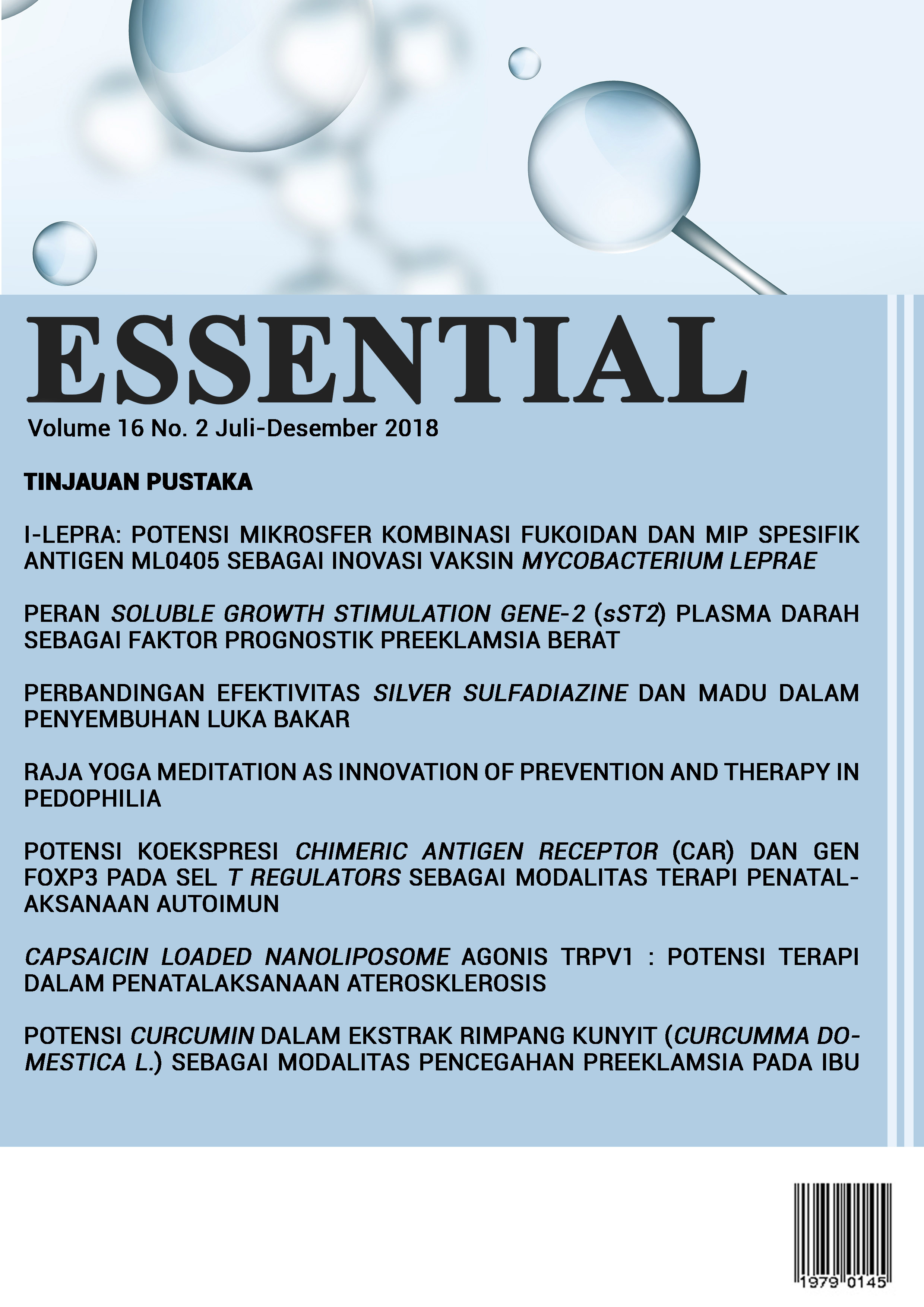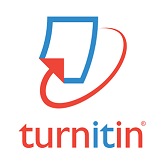POTENSI CURCUMIN DALAM EKSTRAK RIMPANG KUNYIT (CURCUMMA DOMESTICA L.) SEBAGAI MODALITAS PENCEGAHAN PREEKLAMSIA PADA IBU HAMIL DENGAN RESISTANSI INSULIN
Abstract
Introduction: Preeclampsia is a pregnancy disorder characterized by significantly increased blood pressure (systolic pressure ?140 mmHg, diastolic pressure ?90 mmHg) induced by pregnancy and proteinuria. Preeclampsia is often associated with hyperglycemic state, and studies found that hyperglicemia increases the risk of preeclampsia up to three times higher.
Discussion: There are correlations between insulin resistance and glucose intolerance with preeclampsia, shown by the statistics that 20% and 15% of pregnant women with DM Type 1 and Type 2 respectively will develop preeclampsia. Excessive glucose level could induce intracellular changes in cytotrophoblasts that causes placental abnormalities and leads to preclampsia. Recent studies found that hyperglicemia treatment could reduce the risk of preeclampsia up to 54% (RR:0,46;95% CI:0,22-0,97). Turmeric extract contains curcumin that is known for its antidiabetic activity. Curcumin can reduce the insulin resistance and glucose intolerance by inhibition of ROS production to maintain the viability of islet cells, suppression of inflamatory cytokines (TNF-?, IL-6, NFkB) production, stimulation of glucose transporter (GLUT-4) expression and glucose clearance, and suppression of FFA level.
Conclusion: Curcumin is potential to be used as a new modality to prevent preeclampsia on women with insulin resistance and glucose intolerance, but the exact amount of turmeric extract or curcumin concentration needed to achieve the desired effect is still unknown.
Downloads
References
2. MP, Dachlan EG, Dekker G. Pulmonary edema in preeclampsia: an Indonesian case–control study. J Matern Neonatal Med. 2017.
3. Gilbert JS, Ryan MJ, LaMarca BB, Sedeek M, Murphy SR, Granger JP. Pathophysiology of Hypertension During Preeclampsia: Linking Placental Ischemia With Endothelial Dysfunction. American Journal Physiology Heart Circulation Physiology. 2008;294(1):541–50.
4. Abhari FR, Andarieh MG, Farokhfar A, Ahmady S. Estimating rate of insulin resistance in patients with preeclampsia using HOMA-IR Index and comparison with nonpreeclampsia pregnant women. Biomed Res Int. 2014;1(1):1-6
5. Leeman L, Dresang LT, Fontaine P. Hypertensive disorders of pregnancy. American Family Physician. 2016;93(2):121–127.
6. Melamed N, Ray JG, Hladunewich M, Cox B, Kingdom JC. Gestational Hypertension and Preeclampsia: Are They the Same Disease? J Obstet Gynaecol Canada. 2014;36(7):642–647.
7. Gathiram P, Moodley J. Pre-eclampsia: its pathogenesis and pathophysiolgy. Cardiovasc J Afr [Internet]. 2016;27(2):71–8.
8. Yeni C, Mose J, Ruslami R, Maskoen A, Fauziah P. EP16.05: Effect of curcumin in decreasing MDA level in pre-eclampsia-induced human umbilical vein endothelial cell (HUVEC). Ultrasound in Obstetrics & Gynecology. 2017;50:333-333.
9. O’Gorman N, Wright D, Syngelaki A, Akolekar R, Wright A, Poon LC, et al. Competing risks model in screening for preeclampsia by maternal factors and biomarkers at 11-13 weeks’ gestation. American Journal of Obstetrics and Gynecology. 2015.
10. Weissgerber TL, Mudd LM. Preeclampsia and Diabetes. Current Diabetes Reports. 2015;15(3):1–16.
11. Valdes E, Sepulveda-Martinez A, Manukian B, Parra-Cordero M. Assessment of pregestational insulin resistance as a risk factor of preeclampsia. Gynecol Obstet Invest. 2014;77(2):111–6. doi: 10.1159/000357944.
12. Hauth JC, Clifton RG, Roberts JM, Myatt L, Spong CY, Leveno KJ, et al. Maternal insulin resistance and preeclampsia. Am J Obstet Gynecology. 2011;204(4):327 e1–6. doi: 10.1016/j.ajog.2011.02.024.
13. Alsnes IV, Janszky I, Forman MR, Vatten LJ, Okland I. A population-based study of associations between preeclampsia and later cardiovascular risk factors. Am J Obstet Gynecol. 2014 doi: 10.1016/j.ajog.2014.06.026.
14. Persson M, Norman M, Hanson U. Obstetric and perinatal outcomes in type 1 diabetic pregnancies: A large, population-based study. Diabetes Care. 2009;32(11):2005–9. doi:dc09-0656 [pii] 10.2337/dc09-0656.
15. Knight KM, Thornburg LL, Pressman EK. Pregnancy outcomes in type 2 diabetic patients as compared with type 1 diabetic patients and nondiabetic controls. J Reprod Med. 2012;57(9-10):397–404.
16. Groen B, Links TP, van den Berg PP, Hellinga M, Moerman S, Visser GH, et al. Similar adverse pregnancy outcome in native and nonnative dutch women with pregestational type 2 diabetes: a multicentre retrospective study. ISRN obstetrics and gynecology. 2013;2013:3614-3635. doi: 10.1155/2013/361435.
17. Uddin MN, Beeram MR, Kuehl TJ. Diabetes Mellitus and Preeclampsia. 2013. Med J Obstet Gynecol 1(3): 1016.
18. Sukandar E, Sudjana P, Adnyana I, Setiawan A, Yuniarni U. Recent Study of Turmeric in Combination with Garlic as Antidiabetic Agent. Procedia Chemistry. 2014;13:44-56.
19. Landon MB, Spong CY, Thom E, Carpenter MW, Ramin SM, Casey B, et al. A multicenter, randomized trial of treatment for mild gestational diabetes. N Engl J Med. 2009;361(14):1339–48. doi: 10.1056/NEJMoa0902430.
20. Khasiat Kunyit sebagai Obat Tradisional dan Lainnya. Warta Penelitian dan Pengembangan Tanaman Industri. 2013;19(2):5-9.
21. Zhang D, Fu M, Gao S-H, Liu J-L. Curcumin and Diabetes: A Systematic Review. Evidence-based Complementary and Alternative Medicine : eCAM. 2013;2013:636053. doi:10.1155/2013/636053.
22. Blaslov, Kristina. Curcumin-a polyphenol with molecular targets for diabetes control?. 2017. Endocrine Oncology and Metabolism;3:43-48. doi:10.21040/eom/2017.3.2.2.


 SUBMISSION
SUBMISSION
















